Business Issues and the Context of HR: Detailed Analysis Report
VerifiedAdded on 2021/05/30
|23
|7219
|47
Report
AI Summary
This report delves into the intricate relationship between business issues and the context of Human Resources. It begins by exploring the key contemporary business issues and external factors influencing organizations, such as government policies, legal regulations, globalization, workforce demographics, and technological trends, and assesses their impact on HR functions. The report then investigates how organizational and HR strategies and practices are shaped and developed, analyzing the forces that shape the HR agenda, including supporting organizational performance, relationship with senior management, talent development, employee engagement, and organizational culture. The analysis includes a discussion of the different factors that influence the HR agenda, along with tools for analyzing the business environment and explaining the stages of strategy formulation and implementation, and the role of HR. Finally, the report examines the role of HR in identifying and responding to changes in the business environment, evaluating business performance, and assessing various sources of business and contextual data for planning purposes. The report underscores the importance of HR professionals understanding and adapting to these dynamic factors to effectively contribute to organizational success.
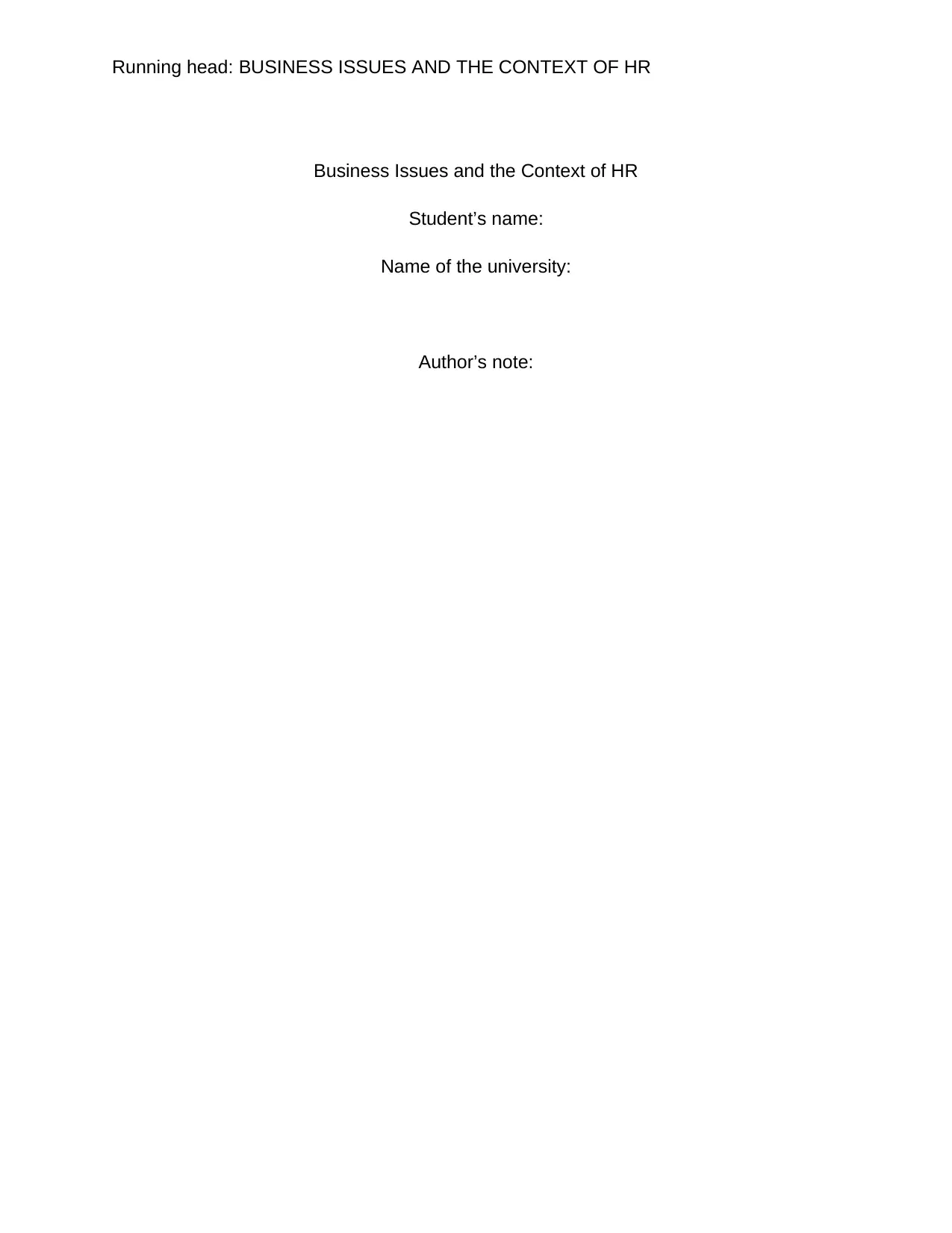
Running head: BUSINESS ISSUES AND THE CONTEXT OF HR
Business Issues and the Context of HR
Student’s name:
Name of the university:
Author’s note:
Business Issues and the Context of HR
Student’s name:
Name of the university:
Author’s note:
Paraphrase This Document
Need a fresh take? Get an instant paraphrase of this document with our AI Paraphraser
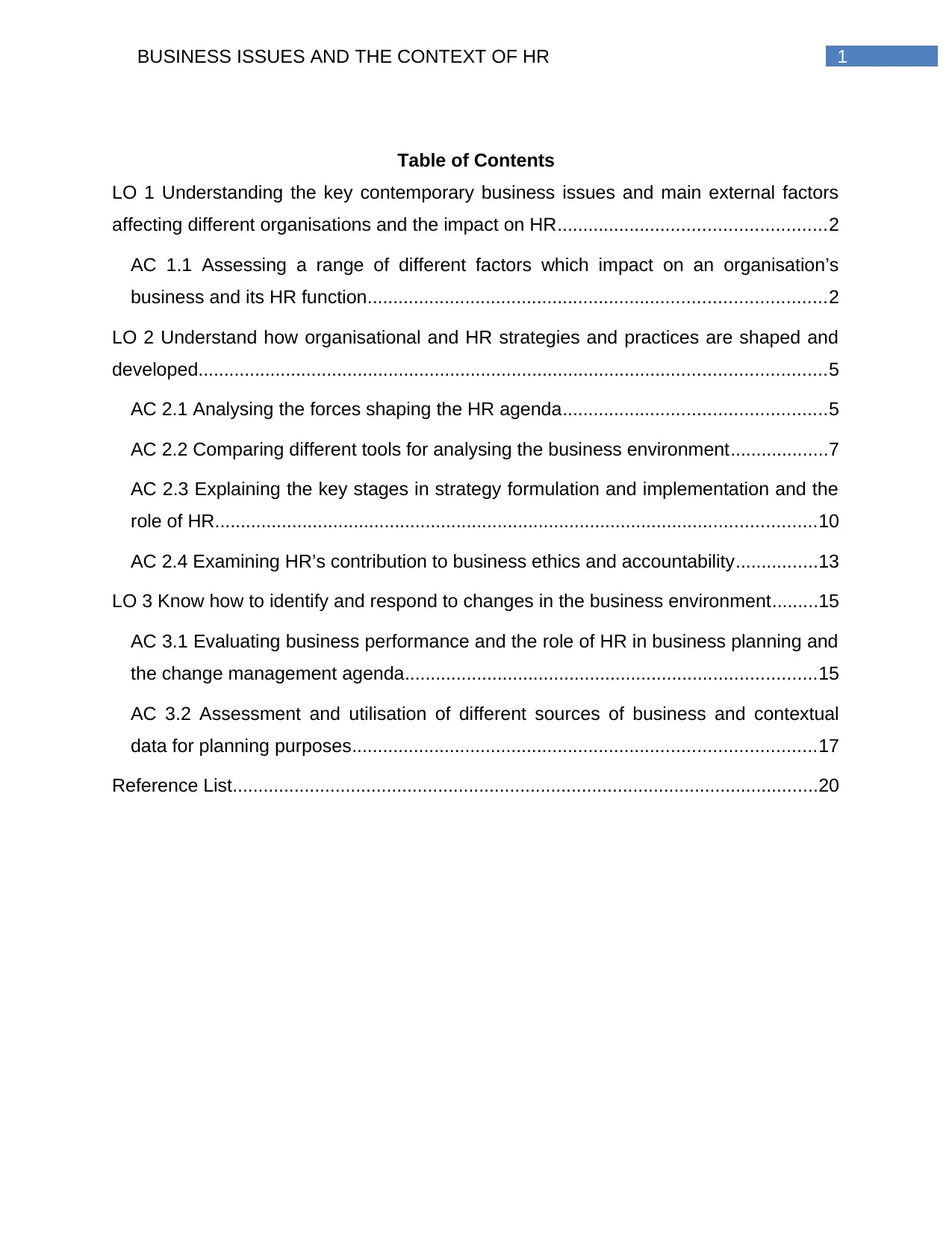
1BUSINESS ISSUES AND THE CONTEXT OF HR
Table of Contents
LO 1 Understanding the key contemporary business issues and main external factors
affecting different organisations and the impact on HR....................................................2
AC 1.1 Assessing a range of different factors which impact on an organisation’s
business and its HR function.........................................................................................2
LO 2 Understand how organisational and HR strategies and practices are shaped and
developed..........................................................................................................................5
AC 2.1 Analysing the forces shaping the HR agenda...................................................5
AC 2.2 Comparing different tools for analysing the business environment...................7
AC 2.3 Explaining the key stages in strategy formulation and implementation and the
role of HR.....................................................................................................................10
AC 2.4 Examining HR’s contribution to business ethics and accountability................13
LO 3 Know how to identify and respond to changes in the business environment.........15
AC 3.1 Evaluating business performance and the role of HR in business planning and
the change management agenda................................................................................15
AC 3.2 Assessment and utilisation of different sources of business and contextual
data for planning purposes..........................................................................................17
Reference List..................................................................................................................20
Table of Contents
LO 1 Understanding the key contemporary business issues and main external factors
affecting different organisations and the impact on HR....................................................2
AC 1.1 Assessing a range of different factors which impact on an organisation’s
business and its HR function.........................................................................................2
LO 2 Understand how organisational and HR strategies and practices are shaped and
developed..........................................................................................................................5
AC 2.1 Analysing the forces shaping the HR agenda...................................................5
AC 2.2 Comparing different tools for analysing the business environment...................7
AC 2.3 Explaining the key stages in strategy formulation and implementation and the
role of HR.....................................................................................................................10
AC 2.4 Examining HR’s contribution to business ethics and accountability................13
LO 3 Know how to identify and respond to changes in the business environment.........15
AC 3.1 Evaluating business performance and the role of HR in business planning and
the change management agenda................................................................................15
AC 3.2 Assessment and utilisation of different sources of business and contextual
data for planning purposes..........................................................................................17
Reference List..................................................................................................................20
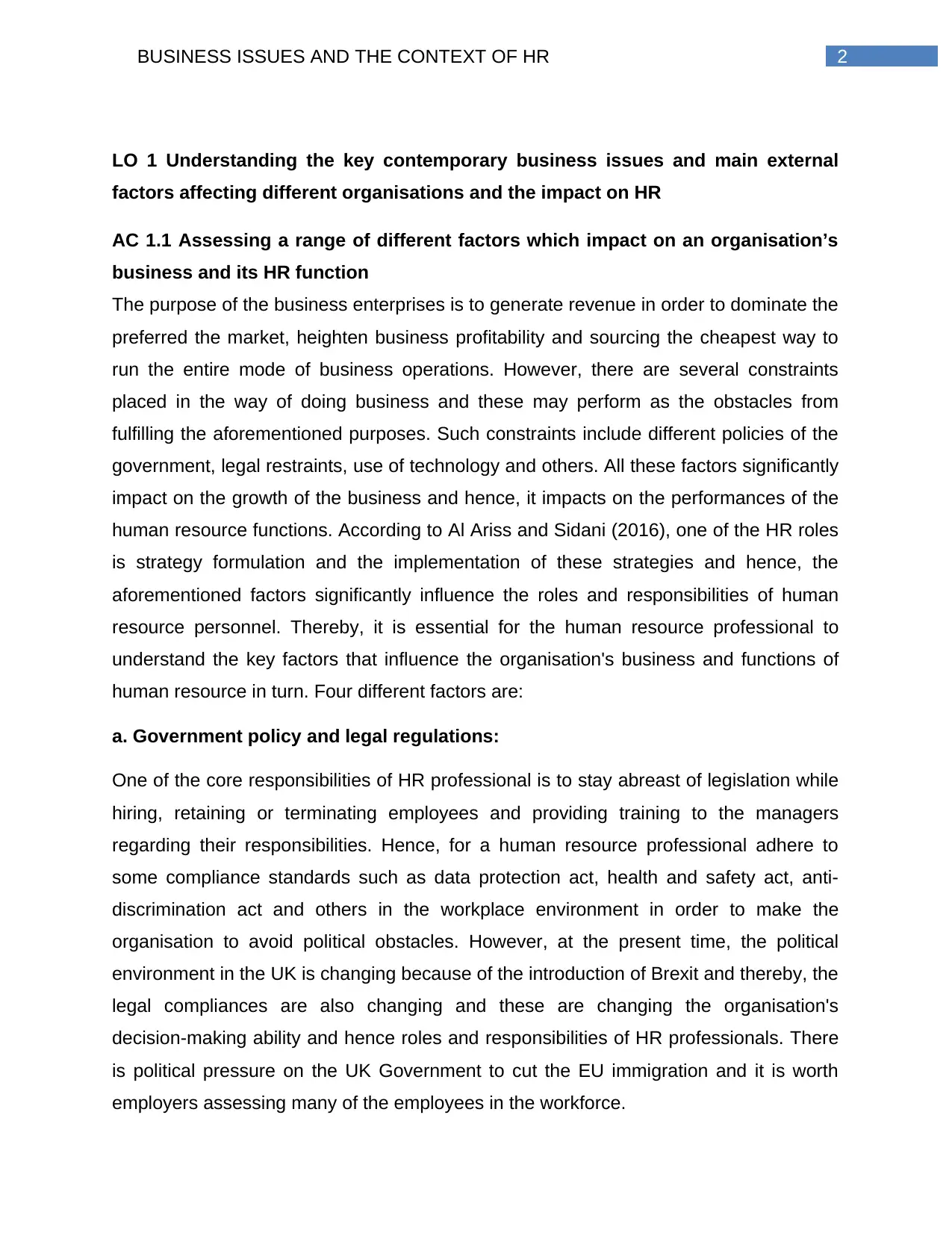
2BUSINESS ISSUES AND THE CONTEXT OF HR
LO 1 Understanding the key contemporary business issues and main external
factors affecting different organisations and the impact on HR
AC 1.1 Assessing a range of different factors which impact on an organisation’s
business and its HR function
The purpose of the business enterprises is to generate revenue in order to dominate the
preferred the market, heighten business profitability and sourcing the cheapest way to
run the entire mode of business operations. However, there are several constraints
placed in the way of doing business and these may perform as the obstacles from
fulfilling the aforementioned purposes. Such constraints include different policies of the
government, legal restraints, use of technology and others. All these factors significantly
impact on the growth of the business and hence, it impacts on the performances of the
human resource functions. According to Al Ariss and Sidani (2016), one of the HR roles
is strategy formulation and the implementation of these strategies and hence, the
aforementioned factors significantly influence the roles and responsibilities of human
resource personnel. Thereby, it is essential for the human resource professional to
understand the key factors that influence the organisation's business and functions of
human resource in turn. Four different factors are:
a. Government policy and legal regulations:
One of the core responsibilities of HR professional is to stay abreast of legislation while
hiring, retaining or terminating employees and providing training to the managers
regarding their responsibilities. Hence, for a human resource professional adhere to
some compliance standards such as data protection act, health and safety act, anti-
discrimination act and others in the workplace environment in order to make the
organisation to avoid political obstacles. However, at the present time, the political
environment in the UK is changing because of the introduction of Brexit and thereby, the
legal compliances are also changing and these are changing the organisation's
decision-making ability and hence roles and responsibilities of HR professionals. There
is political pressure on the UK Government to cut the EU immigration and it is worth
employers assessing many of the employees in the workforce.
LO 1 Understanding the key contemporary business issues and main external
factors affecting different organisations and the impact on HR
AC 1.1 Assessing a range of different factors which impact on an organisation’s
business and its HR function
The purpose of the business enterprises is to generate revenue in order to dominate the
preferred the market, heighten business profitability and sourcing the cheapest way to
run the entire mode of business operations. However, there are several constraints
placed in the way of doing business and these may perform as the obstacles from
fulfilling the aforementioned purposes. Such constraints include different policies of the
government, legal restraints, use of technology and others. All these factors significantly
impact on the growth of the business and hence, it impacts on the performances of the
human resource functions. According to Al Ariss and Sidani (2016), one of the HR roles
is strategy formulation and the implementation of these strategies and hence, the
aforementioned factors significantly influence the roles and responsibilities of human
resource personnel. Thereby, it is essential for the human resource professional to
understand the key factors that influence the organisation's business and functions of
human resource in turn. Four different factors are:
a. Government policy and legal regulations:
One of the core responsibilities of HR professional is to stay abreast of legislation while
hiring, retaining or terminating employees and providing training to the managers
regarding their responsibilities. Hence, for a human resource professional adhere to
some compliance standards such as data protection act, health and safety act, anti-
discrimination act and others in the workplace environment in order to make the
organisation to avoid political obstacles. However, at the present time, the political
environment in the UK is changing because of the introduction of Brexit and thereby, the
legal compliances are also changing and these are changing the organisation's
decision-making ability and hence roles and responsibilities of HR professionals. There
is political pressure on the UK Government to cut the EU immigration and it is worth
employers assessing many of the employees in the workforce.
⊘ This is a preview!⊘
Do you want full access?
Subscribe today to unlock all pages.

Trusted by 1+ million students worldwide
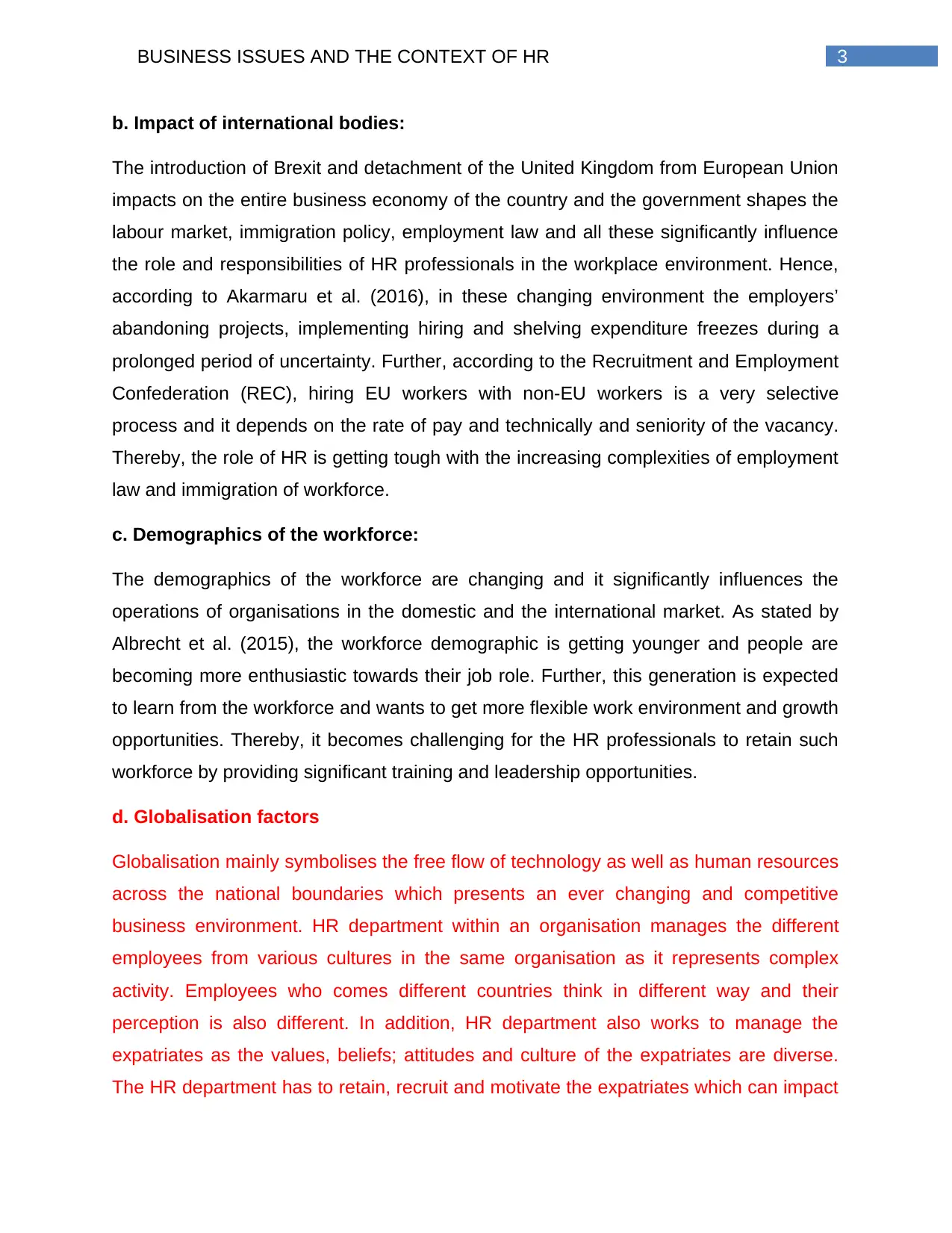
3BUSINESS ISSUES AND THE CONTEXT OF HR
b. Impact of international bodies:
The introduction of Brexit and detachment of the United Kingdom from European Union
impacts on the entire business economy of the country and the government shapes the
labour market, immigration policy, employment law and all these significantly influence
the role and responsibilities of HR professionals in the workplace environment. Hence,
according to Akarmaru et al. (2016), in these changing environment the employers’
abandoning projects, implementing hiring and shelving expenditure freezes during a
prolonged period of uncertainty. Further, according to the Recruitment and Employment
Confederation (REC), hiring EU workers with non-EU workers is a very selective
process and it depends on the rate of pay and technically and seniority of the vacancy.
Thereby, the role of HR is getting tough with the increasing complexities of employment
law and immigration of workforce.
c. Demographics of the workforce:
The demographics of the workforce are changing and it significantly influences the
operations of organisations in the domestic and the international market. As stated by
Albrecht et al. (2015), the workforce demographic is getting younger and people are
becoming more enthusiastic towards their job role. Further, this generation is expected
to learn from the workforce and wants to get more flexible work environment and growth
opportunities. Thereby, it becomes challenging for the HR professionals to retain such
workforce by providing significant training and leadership opportunities.
d. Globalisation factors
Globalisation mainly symbolises the free flow of technology as well as human resources
across the national boundaries which presents an ever changing and competitive
business environment. HR department within an organisation manages the different
employees from various cultures in the same organisation as it represents complex
activity. Employees who comes different countries think in different way and their
perception is also different. In addition, HR department also works to manage the
expatriates as the values, beliefs; attitudes and culture of the expatriates are diverse.
The HR department has to retain, recruit and motivate the expatriates which can impact
b. Impact of international bodies:
The introduction of Brexit and detachment of the United Kingdom from European Union
impacts on the entire business economy of the country and the government shapes the
labour market, immigration policy, employment law and all these significantly influence
the role and responsibilities of HR professionals in the workplace environment. Hence,
according to Akarmaru et al. (2016), in these changing environment the employers’
abandoning projects, implementing hiring and shelving expenditure freezes during a
prolonged period of uncertainty. Further, according to the Recruitment and Employment
Confederation (REC), hiring EU workers with non-EU workers is a very selective
process and it depends on the rate of pay and technically and seniority of the vacancy.
Thereby, the role of HR is getting tough with the increasing complexities of employment
law and immigration of workforce.
c. Demographics of the workforce:
The demographics of the workforce are changing and it significantly influences the
operations of organisations in the domestic and the international market. As stated by
Albrecht et al. (2015), the workforce demographic is getting younger and people are
becoming more enthusiastic towards their job role. Further, this generation is expected
to learn from the workforce and wants to get more flexible work environment and growth
opportunities. Thereby, it becomes challenging for the HR professionals to retain such
workforce by providing significant training and leadership opportunities.
d. Globalisation factors
Globalisation mainly symbolises the free flow of technology as well as human resources
across the national boundaries which presents an ever changing and competitive
business environment. HR department within an organisation manages the different
employees from various cultures in the same organisation as it represents complex
activity. Employees who comes different countries think in different way and their
perception is also different. In addition, HR department also works to manage the
expatriates as the values, beliefs; attitudes and culture of the expatriates are diverse.
The HR department has to retain, recruit and motivate the expatriates which can impact
Paraphrase This Document
Need a fresh take? Get an instant paraphrase of this document with our AI Paraphraser

4BUSINESS ISSUES AND THE CONTEXT OF HR
majorly on the organisations. In globalisation, the employees who come from different
countries have to make themselves acknowledge with the different employment laws.
The understanding of the different laws can provide benefits to have monetary
advantages and flexi-timings. As stated by Begg and Ward (2012), outsources staffs
need to manage the influence of globalisation as managing the KPO and BPO
employees have to work in different language, culture and working different shift times.
HR departments have to maintain the corporate social responsibility participating in the
activities like betterment of the society which have emerged from western countries. HR
department has to manage the virtual employees where majority of the information
technology based-organisations work in different locations.
e. Gen Y factors
Gen Y is the demographic which cohort containing the people born between around
1985 and 1995. In the workplace; Gen Y are experienced and they faced the problem
regarding the poor economic situations. HR functions make sure that policies can be
targeted to make the desire to be fulfilled as the Gen Y tries to make their life god with
proper work-life balance and contribute to the ethical endpoint (Budhwar et al. 2016).
HR department tries to make employee-centred workplace keeping the Gen Y in pivotal
figure and Gen Y always tries to learn. Gen Y employees want to have the constant
feedback from the HR department and HR management can opt to take the mentorship
f. Impacts of social and technological trends:
The introduction of information technology has a greater impact on the growth of
organisations that exist in the dynamic environment and this, in turn, leads to greater
effectiveness and efficiency of the human resources. Hence, the use of database
management, use of cloud technology and advances of recruitment system increase the
efficiency of the business. Organisations are now able to access workers from remote
areas and the duration of working hours are also enhancing (Guerci et al. 2016).
Examples of social factors that can affect the business are the tastes, fashion and
trends. In the UK, social factors are the ageing population that can impact on the
business. Hence, it becomes essential for the human resource management to focus
majorly on the organisations. In globalisation, the employees who come from different
countries have to make themselves acknowledge with the different employment laws.
The understanding of the different laws can provide benefits to have monetary
advantages and flexi-timings. As stated by Begg and Ward (2012), outsources staffs
need to manage the influence of globalisation as managing the KPO and BPO
employees have to work in different language, culture and working different shift times.
HR departments have to maintain the corporate social responsibility participating in the
activities like betterment of the society which have emerged from western countries. HR
department has to manage the virtual employees where majority of the information
technology based-organisations work in different locations.
e. Gen Y factors
Gen Y is the demographic which cohort containing the people born between around
1985 and 1995. In the workplace; Gen Y are experienced and they faced the problem
regarding the poor economic situations. HR functions make sure that policies can be
targeted to make the desire to be fulfilled as the Gen Y tries to make their life god with
proper work-life balance and contribute to the ethical endpoint (Budhwar et al. 2016).
HR department tries to make employee-centred workplace keeping the Gen Y in pivotal
figure and Gen Y always tries to learn. Gen Y employees want to have the constant
feedback from the HR department and HR management can opt to take the mentorship
f. Impacts of social and technological trends:
The introduction of information technology has a greater impact on the growth of
organisations that exist in the dynamic environment and this, in turn, leads to greater
effectiveness and efficiency of the human resources. Hence, the use of database
management, use of cloud technology and advances of recruitment system increase the
efficiency of the business. Organisations are now able to access workers from remote
areas and the duration of working hours are also enhancing (Guerci et al. 2016).
Examples of social factors that can affect the business are the tastes, fashion and
trends. In the UK, social factors are the ageing population that can impact on the
business. Hence, it becomes essential for the human resource management to focus
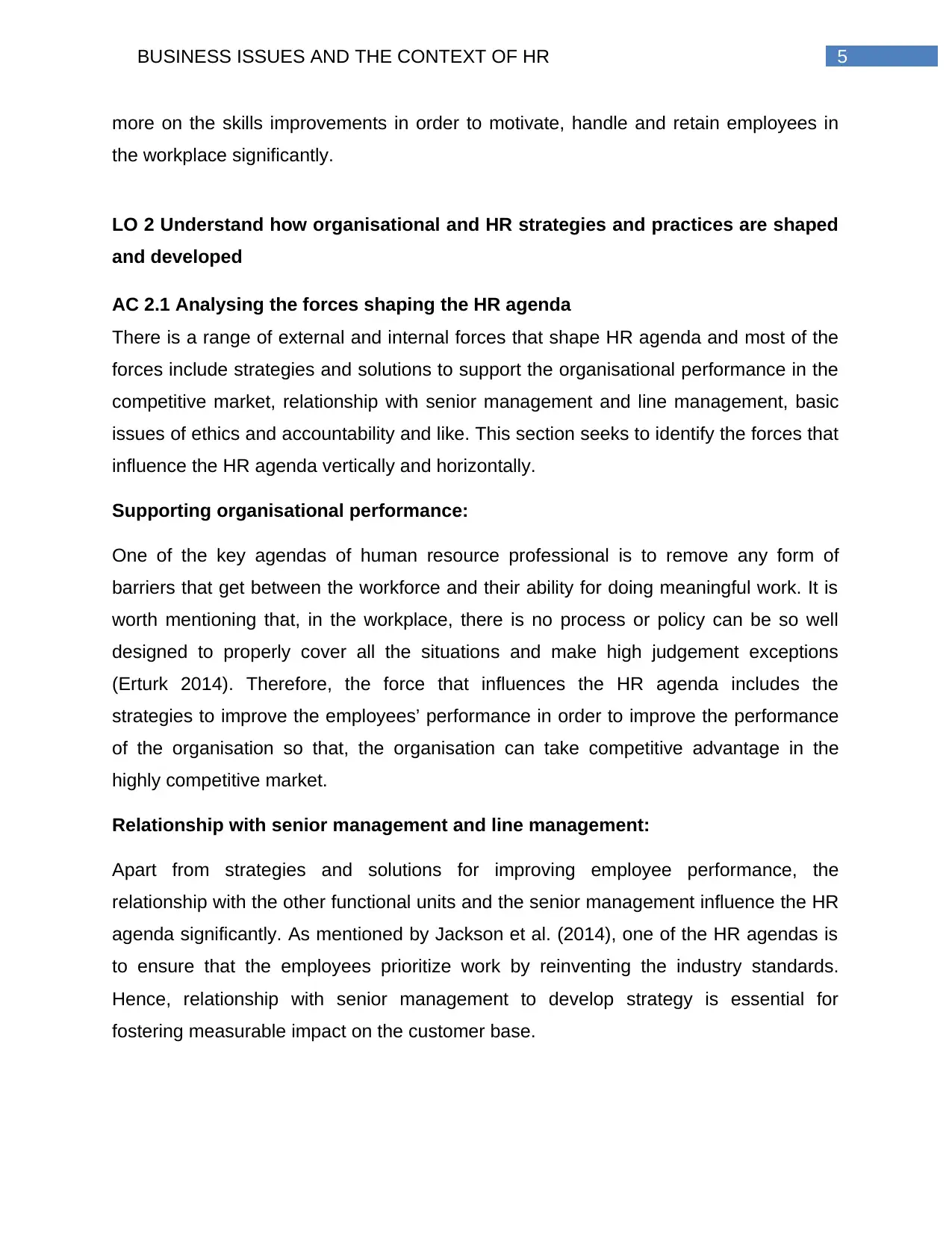
5BUSINESS ISSUES AND THE CONTEXT OF HR
more on the skills improvements in order to motivate, handle and retain employees in
the workplace significantly.
LO 2 Understand how organisational and HR strategies and practices are shaped
and developed
AC 2.1 Analysing the forces shaping the HR agenda
There is a range of external and internal forces that shape HR agenda and most of the
forces include strategies and solutions to support the organisational performance in the
competitive market, relationship with senior management and line management, basic
issues of ethics and accountability and like. This section seeks to identify the forces that
influence the HR agenda vertically and horizontally.
Supporting organisational performance:
One of the key agendas of human resource professional is to remove any form of
barriers that get between the workforce and their ability for doing meaningful work. It is
worth mentioning that, in the workplace, there is no process or policy can be so well
designed to properly cover all the situations and make high judgement exceptions
(Erturk 2014). Therefore, the force that influences the HR agenda includes the
strategies to improve the employees’ performance in order to improve the performance
of the organisation so that, the organisation can take competitive advantage in the
highly competitive market.
Relationship with senior management and line management:
Apart from strategies and solutions for improving employee performance, the
relationship with the other functional units and the senior management influence the HR
agenda significantly. As mentioned by Jackson et al. (2014), one of the HR agendas is
to ensure that the employees prioritize work by reinventing the industry standards.
Hence, relationship with senior management to develop strategy is essential for
fostering measurable impact on the customer base.
more on the skills improvements in order to motivate, handle and retain employees in
the workplace significantly.
LO 2 Understand how organisational and HR strategies and practices are shaped
and developed
AC 2.1 Analysing the forces shaping the HR agenda
There is a range of external and internal forces that shape HR agenda and most of the
forces include strategies and solutions to support the organisational performance in the
competitive market, relationship with senior management and line management, basic
issues of ethics and accountability and like. This section seeks to identify the forces that
influence the HR agenda vertically and horizontally.
Supporting organisational performance:
One of the key agendas of human resource professional is to remove any form of
barriers that get between the workforce and their ability for doing meaningful work. It is
worth mentioning that, in the workplace, there is no process or policy can be so well
designed to properly cover all the situations and make high judgement exceptions
(Erturk 2014). Therefore, the force that influences the HR agenda includes the
strategies to improve the employees’ performance in order to improve the performance
of the organisation so that, the organisation can take competitive advantage in the
highly competitive market.
Relationship with senior management and line management:
Apart from strategies and solutions for improving employee performance, the
relationship with the other functional units and the senior management influence the HR
agenda significantly. As mentioned by Jackson et al. (2014), one of the HR agendas is
to ensure that the employees prioritize work by reinventing the industry standards.
Hence, relationship with senior management to develop strategy is essential for
fostering measurable impact on the customer base.
⊘ This is a preview!⊘
Do you want full access?
Subscribe today to unlock all pages.

Trusted by 1+ million students worldwide
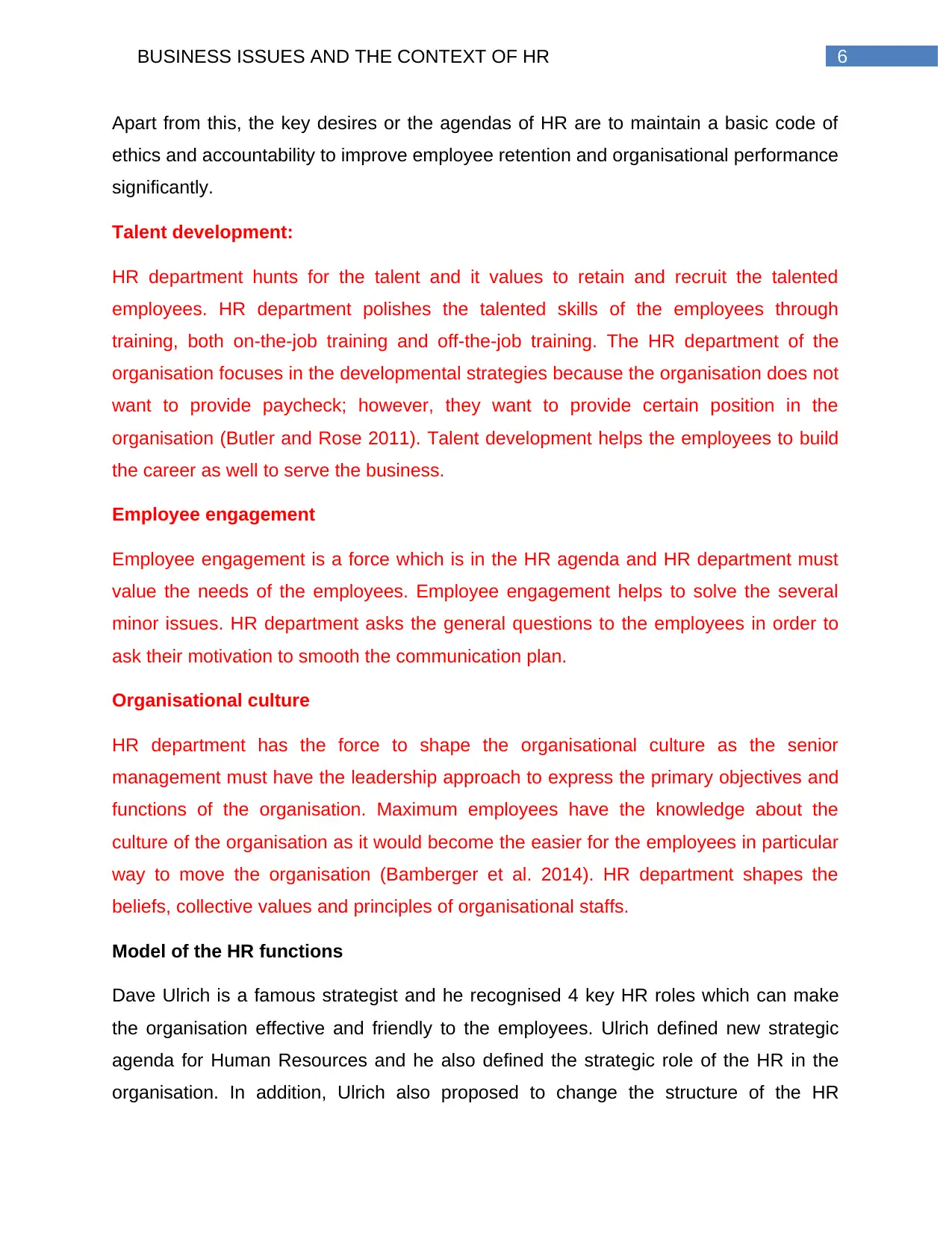
6BUSINESS ISSUES AND THE CONTEXT OF HR
Apart from this, the key desires or the agendas of HR are to maintain a basic code of
ethics and accountability to improve employee retention and organisational performance
significantly.
Talent development:
HR department hunts for the talent and it values to retain and recruit the talented
employees. HR department polishes the talented skills of the employees through
training, both on-the-job training and off-the-job training. The HR department of the
organisation focuses in the developmental strategies because the organisation does not
want to provide paycheck; however, they want to provide certain position in the
organisation (Butler and Rose 2011). Talent development helps the employees to build
the career as well to serve the business.
Employee engagement
Employee engagement is a force which is in the HR agenda and HR department must
value the needs of the employees. Employee engagement helps to solve the several
minor issues. HR department asks the general questions to the employees in order to
ask their motivation to smooth the communication plan.
Organisational culture
HR department has the force to shape the organisational culture as the senior
management must have the leadership approach to express the primary objectives and
functions of the organisation. Maximum employees have the knowledge about the
culture of the organisation as it would become the easier for the employees in particular
way to move the organisation (Bamberger et al. 2014). HR department shapes the
beliefs, collective values and principles of organisational staffs.
Model of the HR functions
Dave Ulrich is a famous strategist and he recognised 4 key HR roles which can make
the organisation effective and friendly to the employees. Ulrich defined new strategic
agenda for Human Resources and he also defined the strategic role of the HR in the
organisation. In addition, Ulrich also proposed to change the structure of the HR
Apart from this, the key desires or the agendas of HR are to maintain a basic code of
ethics and accountability to improve employee retention and organisational performance
significantly.
Talent development:
HR department hunts for the talent and it values to retain and recruit the talented
employees. HR department polishes the talented skills of the employees through
training, both on-the-job training and off-the-job training. The HR department of the
organisation focuses in the developmental strategies because the organisation does not
want to provide paycheck; however, they want to provide certain position in the
organisation (Butler and Rose 2011). Talent development helps the employees to build
the career as well to serve the business.
Employee engagement
Employee engagement is a force which is in the HR agenda and HR department must
value the needs of the employees. Employee engagement helps to solve the several
minor issues. HR department asks the general questions to the employees in order to
ask their motivation to smooth the communication plan.
Organisational culture
HR department has the force to shape the organisational culture as the senior
management must have the leadership approach to express the primary objectives and
functions of the organisation. Maximum employees have the knowledge about the
culture of the organisation as it would become the easier for the employees in particular
way to move the organisation (Bamberger et al. 2014). HR department shapes the
beliefs, collective values and principles of organisational staffs.
Model of the HR functions
Dave Ulrich is a famous strategist and he recognised 4 key HR roles which can make
the organisation effective and friendly to the employees. Ulrich defined new strategic
agenda for Human Resources and he also defined the strategic role of the HR in the
organisation. In addition, Ulrich also proposed to change the structure of the HR
Paraphrase This Document
Need a fresh take? Get an instant paraphrase of this document with our AI Paraphraser
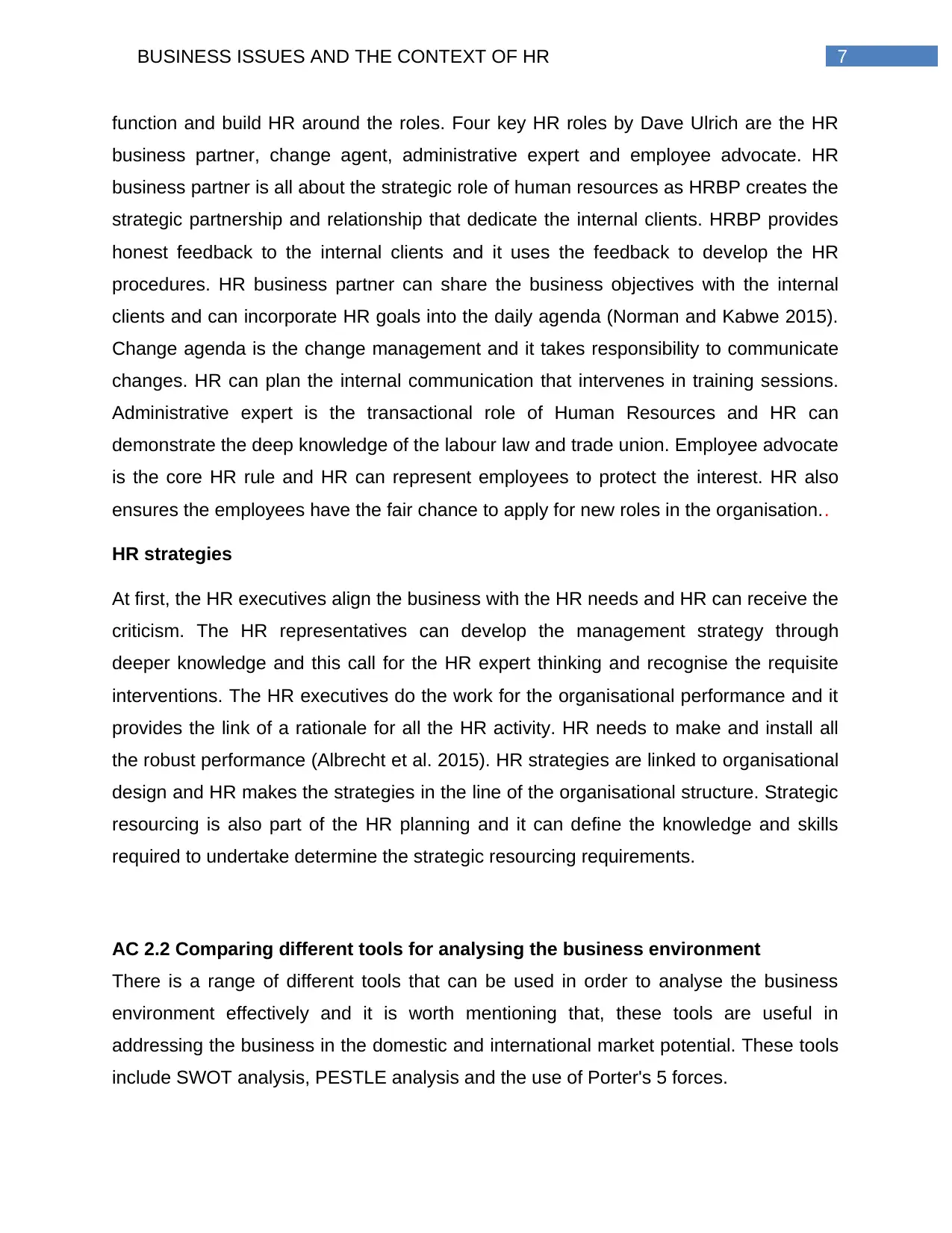
7BUSINESS ISSUES AND THE CONTEXT OF HR
function and build HR around the roles. Four key HR roles by Dave Ulrich are the HR
business partner, change agent, administrative expert and employee advocate. HR
business partner is all about the strategic role of human resources as HRBP creates the
strategic partnership and relationship that dedicate the internal clients. HRBP provides
honest feedback to the internal clients and it uses the feedback to develop the HR
procedures. HR business partner can share the business objectives with the internal
clients and can incorporate HR goals into the daily agenda (Norman and Kabwe 2015).
Change agenda is the change management and it takes responsibility to communicate
changes. HR can plan the internal communication that intervenes in training sessions.
Administrative expert is the transactional role of Human Resources and HR can
demonstrate the deep knowledge of the labour law and trade union. Employee advocate
is the core HR rule and HR can represent employees to protect the interest. HR also
ensures the employees have the fair chance to apply for new roles in the organisation..
HR strategies
At first, the HR executives align the business with the HR needs and HR can receive the
criticism. The HR representatives can develop the management strategy through
deeper knowledge and this call for the HR expert thinking and recognise the requisite
interventions. The HR executives do the work for the organisational performance and it
provides the link of a rationale for all the HR activity. HR needs to make and install all
the robust performance (Albrecht et al. 2015). HR strategies are linked to organisational
design and HR makes the strategies in the line of the organisational structure. Strategic
resourcing is also part of the HR planning and it can define the knowledge and skills
required to undertake determine the strategic resourcing requirements.
AC 2.2 Comparing different tools for analysing the business environment
There is a range of different tools that can be used in order to analyse the business
environment effectively and it is worth mentioning that, these tools are useful in
addressing the business in the domestic and international market potential. These tools
include SWOT analysis, PESTLE analysis and the use of Porter's 5 forces.
function and build HR around the roles. Four key HR roles by Dave Ulrich are the HR
business partner, change agent, administrative expert and employee advocate. HR
business partner is all about the strategic role of human resources as HRBP creates the
strategic partnership and relationship that dedicate the internal clients. HRBP provides
honest feedback to the internal clients and it uses the feedback to develop the HR
procedures. HR business partner can share the business objectives with the internal
clients and can incorporate HR goals into the daily agenda (Norman and Kabwe 2015).
Change agenda is the change management and it takes responsibility to communicate
changes. HR can plan the internal communication that intervenes in training sessions.
Administrative expert is the transactional role of Human Resources and HR can
demonstrate the deep knowledge of the labour law and trade union. Employee advocate
is the core HR rule and HR can represent employees to protect the interest. HR also
ensures the employees have the fair chance to apply for new roles in the organisation..
HR strategies
At first, the HR executives align the business with the HR needs and HR can receive the
criticism. The HR representatives can develop the management strategy through
deeper knowledge and this call for the HR expert thinking and recognise the requisite
interventions. The HR executives do the work for the organisational performance and it
provides the link of a rationale for all the HR activity. HR needs to make and install all
the robust performance (Albrecht et al. 2015). HR strategies are linked to organisational
design and HR makes the strategies in the line of the organisational structure. Strategic
resourcing is also part of the HR planning and it can define the knowledge and skills
required to undertake determine the strategic resourcing requirements.
AC 2.2 Comparing different tools for analysing the business environment
There is a range of different tools that can be used in order to analyse the business
environment effectively and it is worth mentioning that, these tools are useful in
addressing the business in the domestic and international market potential. These tools
include SWOT analysis, PESTLE analysis and the use of Porter's 5 forces.
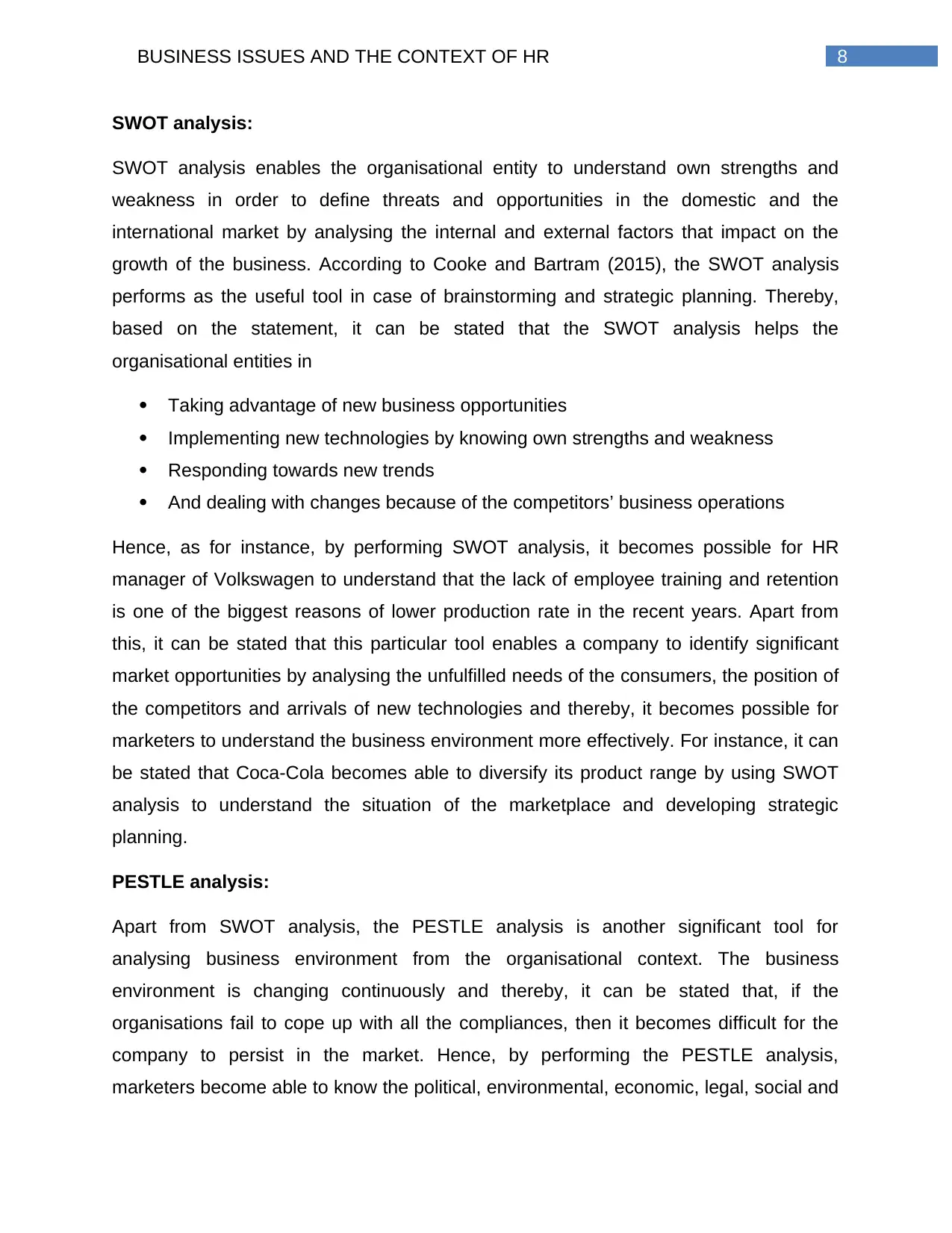
8BUSINESS ISSUES AND THE CONTEXT OF HR
SWOT analysis:
SWOT analysis enables the organisational entity to understand own strengths and
weakness in order to define threats and opportunities in the domestic and the
international market by analysing the internal and external factors that impact on the
growth of the business. According to Cooke and Bartram (2015), the SWOT analysis
performs as the useful tool in case of brainstorming and strategic planning. Thereby,
based on the statement, it can be stated that the SWOT analysis helps the
organisational entities in
Taking advantage of new business opportunities
Implementing new technologies by knowing own strengths and weakness
Responding towards new trends
And dealing with changes because of the competitors’ business operations
Hence, as for instance, by performing SWOT analysis, it becomes possible for HR
manager of Volkswagen to understand that the lack of employee training and retention
is one of the biggest reasons of lower production rate in the recent years. Apart from
this, it can be stated that this particular tool enables a company to identify significant
market opportunities by analysing the unfulfilled needs of the consumers, the position of
the competitors and arrivals of new technologies and thereby, it becomes possible for
marketers to understand the business environment more effectively. For instance, it can
be stated that Coca-Cola becomes able to diversify its product range by using SWOT
analysis to understand the situation of the marketplace and developing strategic
planning.
PESTLE analysis:
Apart from SWOT analysis, the PESTLE analysis is another significant tool for
analysing business environment from the organisational context. The business
environment is changing continuously and thereby, it can be stated that, if the
organisations fail to cope up with all the compliances, then it becomes difficult for the
company to persist in the market. Hence, by performing the PESTLE analysis,
marketers become able to know the political, environmental, economic, legal, social and
SWOT analysis:
SWOT analysis enables the organisational entity to understand own strengths and
weakness in order to define threats and opportunities in the domestic and the
international market by analysing the internal and external factors that impact on the
growth of the business. According to Cooke and Bartram (2015), the SWOT analysis
performs as the useful tool in case of brainstorming and strategic planning. Thereby,
based on the statement, it can be stated that the SWOT analysis helps the
organisational entities in
Taking advantage of new business opportunities
Implementing new technologies by knowing own strengths and weakness
Responding towards new trends
And dealing with changes because of the competitors’ business operations
Hence, as for instance, by performing SWOT analysis, it becomes possible for HR
manager of Volkswagen to understand that the lack of employee training and retention
is one of the biggest reasons of lower production rate in the recent years. Apart from
this, it can be stated that this particular tool enables a company to identify significant
market opportunities by analysing the unfulfilled needs of the consumers, the position of
the competitors and arrivals of new technologies and thereby, it becomes possible for
marketers to understand the business environment more effectively. For instance, it can
be stated that Coca-Cola becomes able to diversify its product range by using SWOT
analysis to understand the situation of the marketplace and developing strategic
planning.
PESTLE analysis:
Apart from SWOT analysis, the PESTLE analysis is another significant tool for
analysing business environment from the organisational context. The business
environment is changing continuously and thereby, it can be stated that, if the
organisations fail to cope up with all the compliances, then it becomes difficult for the
company to persist in the market. Hence, by performing the PESTLE analysis,
marketers become able to know the political, environmental, economic, legal, social and
⊘ This is a preview!⊘
Do you want full access?
Subscribe today to unlock all pages.

Trusted by 1+ million students worldwide
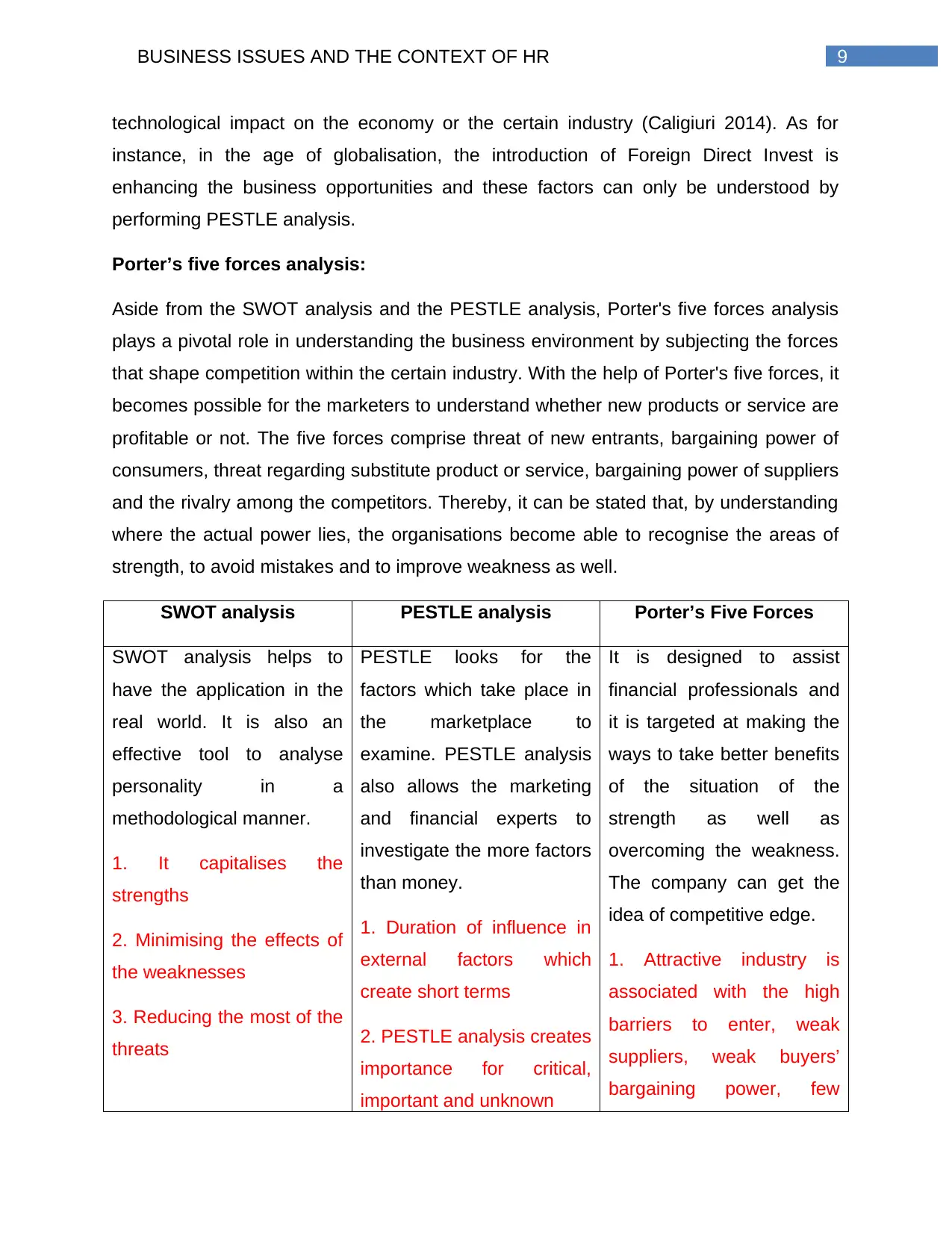
9BUSINESS ISSUES AND THE CONTEXT OF HR
technological impact on the economy or the certain industry (Caligiuri 2014). As for
instance, in the age of globalisation, the introduction of Foreign Direct Invest is
enhancing the business opportunities and these factors can only be understood by
performing PESTLE analysis.
Porter’s five forces analysis:
Aside from the SWOT analysis and the PESTLE analysis, Porter's five forces analysis
plays a pivotal role in understanding the business environment by subjecting the forces
that shape competition within the certain industry. With the help of Porter's five forces, it
becomes possible for the marketers to understand whether new products or service are
profitable or not. The five forces comprise threat of new entrants, bargaining power of
consumers, threat regarding substitute product or service, bargaining power of suppliers
and the rivalry among the competitors. Thereby, it can be stated that, by understanding
where the actual power lies, the organisations become able to recognise the areas of
strength, to avoid mistakes and to improve weakness as well.
SWOT analysis PESTLE analysis Porter’s Five Forces
SWOT analysis helps to
have the application in the
real world. It is also an
effective tool to analyse
personality in a
methodological manner.
1. It capitalises the
strengths
2. Minimising the effects of
the weaknesses
3. Reducing the most of the
threats
PESTLE looks for the
factors which take place in
the marketplace to
examine. PESTLE analysis
also allows the marketing
and financial experts to
investigate the more factors
than money.
1. Duration of influence in
external factors which
create short terms
2. PESTLE analysis creates
importance for critical,
important and unknown
It is designed to assist
financial professionals and
it is targeted at making the
ways to take better benefits
of the situation of the
strength as well as
overcoming the weakness.
The company can get the
idea of competitive edge.
1. Attractive industry is
associated with the high
barriers to enter, weak
suppliers, weak buyers’
bargaining power, few
technological impact on the economy or the certain industry (Caligiuri 2014). As for
instance, in the age of globalisation, the introduction of Foreign Direct Invest is
enhancing the business opportunities and these factors can only be understood by
performing PESTLE analysis.
Porter’s five forces analysis:
Aside from the SWOT analysis and the PESTLE analysis, Porter's five forces analysis
plays a pivotal role in understanding the business environment by subjecting the forces
that shape competition within the certain industry. With the help of Porter's five forces, it
becomes possible for the marketers to understand whether new products or service are
profitable or not. The five forces comprise threat of new entrants, bargaining power of
consumers, threat regarding substitute product or service, bargaining power of suppliers
and the rivalry among the competitors. Thereby, it can be stated that, by understanding
where the actual power lies, the organisations become able to recognise the areas of
strength, to avoid mistakes and to improve weakness as well.
SWOT analysis PESTLE analysis Porter’s Five Forces
SWOT analysis helps to
have the application in the
real world. It is also an
effective tool to analyse
personality in a
methodological manner.
1. It capitalises the
strengths
2. Minimising the effects of
the weaknesses
3. Reducing the most of the
threats
PESTLE looks for the
factors which take place in
the marketplace to
examine. PESTLE analysis
also allows the marketing
and financial experts to
investigate the more factors
than money.
1. Duration of influence in
external factors which
create short terms
2. PESTLE analysis creates
importance for critical,
important and unknown
It is designed to assist
financial professionals and
it is targeted at making the
ways to take better benefits
of the situation of the
strength as well as
overcoming the weakness.
The company can get the
idea of competitive edge.
1. Attractive industry is
associated with the high
barriers to enter, weak
suppliers, weak buyers’
bargaining power, few
Paraphrase This Document
Need a fresh take? Get an instant paraphrase of this document with our AI Paraphraser
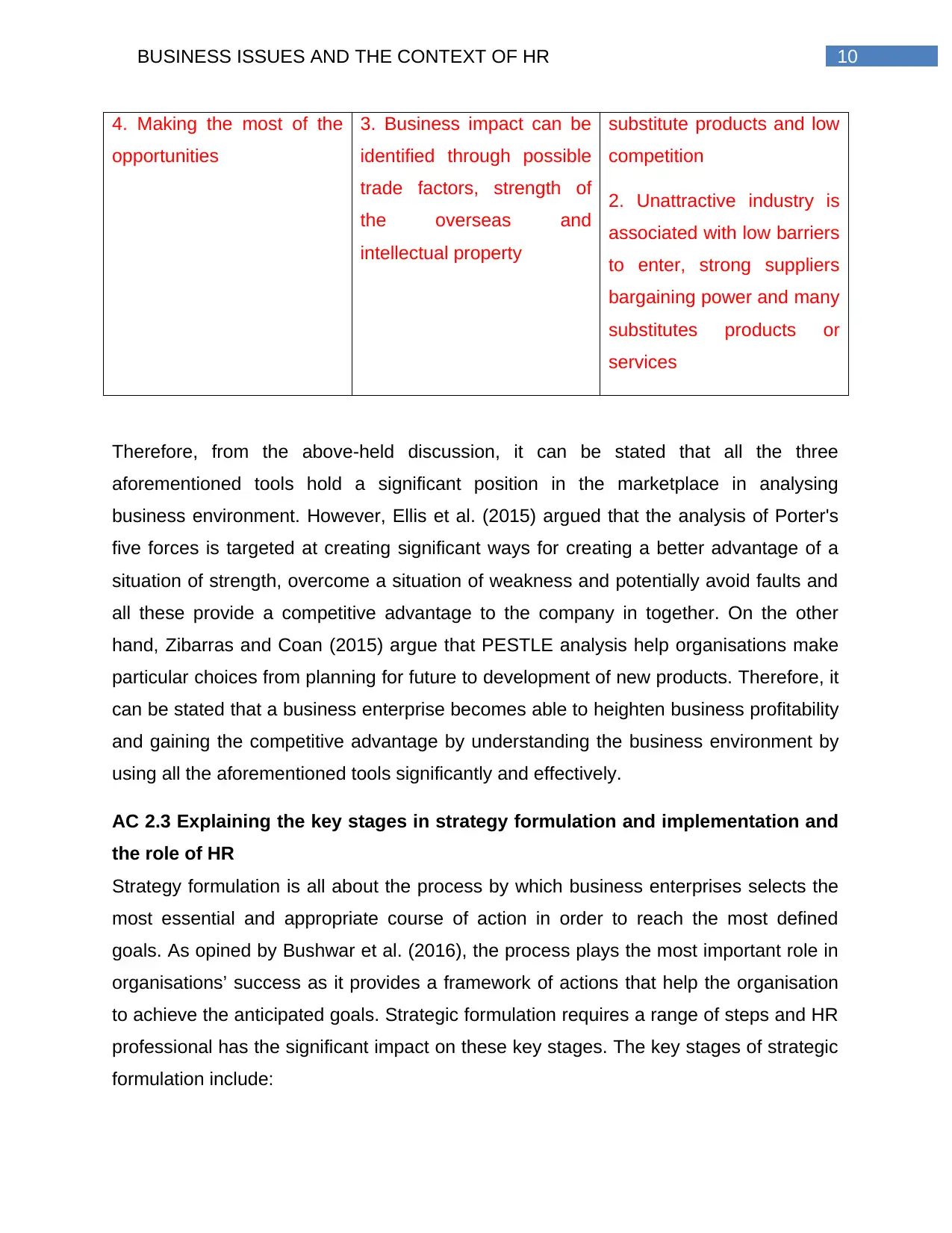
10BUSINESS ISSUES AND THE CONTEXT OF HR
4. Making the most of the
opportunities
3. Business impact can be
identified through possible
trade factors, strength of
the overseas and
intellectual property
substitute products and low
competition
2. Unattractive industry is
associated with low barriers
to enter, strong suppliers
bargaining power and many
substitutes products or
services
Therefore, from the above-held discussion, it can be stated that all the three
aforementioned tools hold a significant position in the marketplace in analysing
business environment. However, Ellis et al. (2015) argued that the analysis of Porter's
five forces is targeted at creating significant ways for creating a better advantage of a
situation of strength, overcome a situation of weakness and potentially avoid faults and
all these provide a competitive advantage to the company in together. On the other
hand, Zibarras and Coan (2015) argue that PESTLE analysis help organisations make
particular choices from planning for future to development of new products. Therefore, it
can be stated that a business enterprise becomes able to heighten business profitability
and gaining the competitive advantage by understanding the business environment by
using all the aforementioned tools significantly and effectively.
AC 2.3 Explaining the key stages in strategy formulation and implementation and
the role of HR
Strategy formulation is all about the process by which business enterprises selects the
most essential and appropriate course of action in order to reach the most defined
goals. As opined by Bushwar et al. (2016), the process plays the most important role in
organisations’ success as it provides a framework of actions that help the organisation
to achieve the anticipated goals. Strategic formulation requires a range of steps and HR
professional has the significant impact on these key stages. The key stages of strategic
formulation include:
4. Making the most of the
opportunities
3. Business impact can be
identified through possible
trade factors, strength of
the overseas and
intellectual property
substitute products and low
competition
2. Unattractive industry is
associated with low barriers
to enter, strong suppliers
bargaining power and many
substitutes products or
services
Therefore, from the above-held discussion, it can be stated that all the three
aforementioned tools hold a significant position in the marketplace in analysing
business environment. However, Ellis et al. (2015) argued that the analysis of Porter's
five forces is targeted at creating significant ways for creating a better advantage of a
situation of strength, overcome a situation of weakness and potentially avoid faults and
all these provide a competitive advantage to the company in together. On the other
hand, Zibarras and Coan (2015) argue that PESTLE analysis help organisations make
particular choices from planning for future to development of new products. Therefore, it
can be stated that a business enterprise becomes able to heighten business profitability
and gaining the competitive advantage by understanding the business environment by
using all the aforementioned tools significantly and effectively.
AC 2.3 Explaining the key stages in strategy formulation and implementation and
the role of HR
Strategy formulation is all about the process by which business enterprises selects the
most essential and appropriate course of action in order to reach the most defined
goals. As opined by Bushwar et al. (2016), the process plays the most important role in
organisations’ success as it provides a framework of actions that help the organisation
to achieve the anticipated goals. Strategic formulation requires a range of steps and HR
professional has the significant impact on these key stages. The key stages of strategic
formulation include:
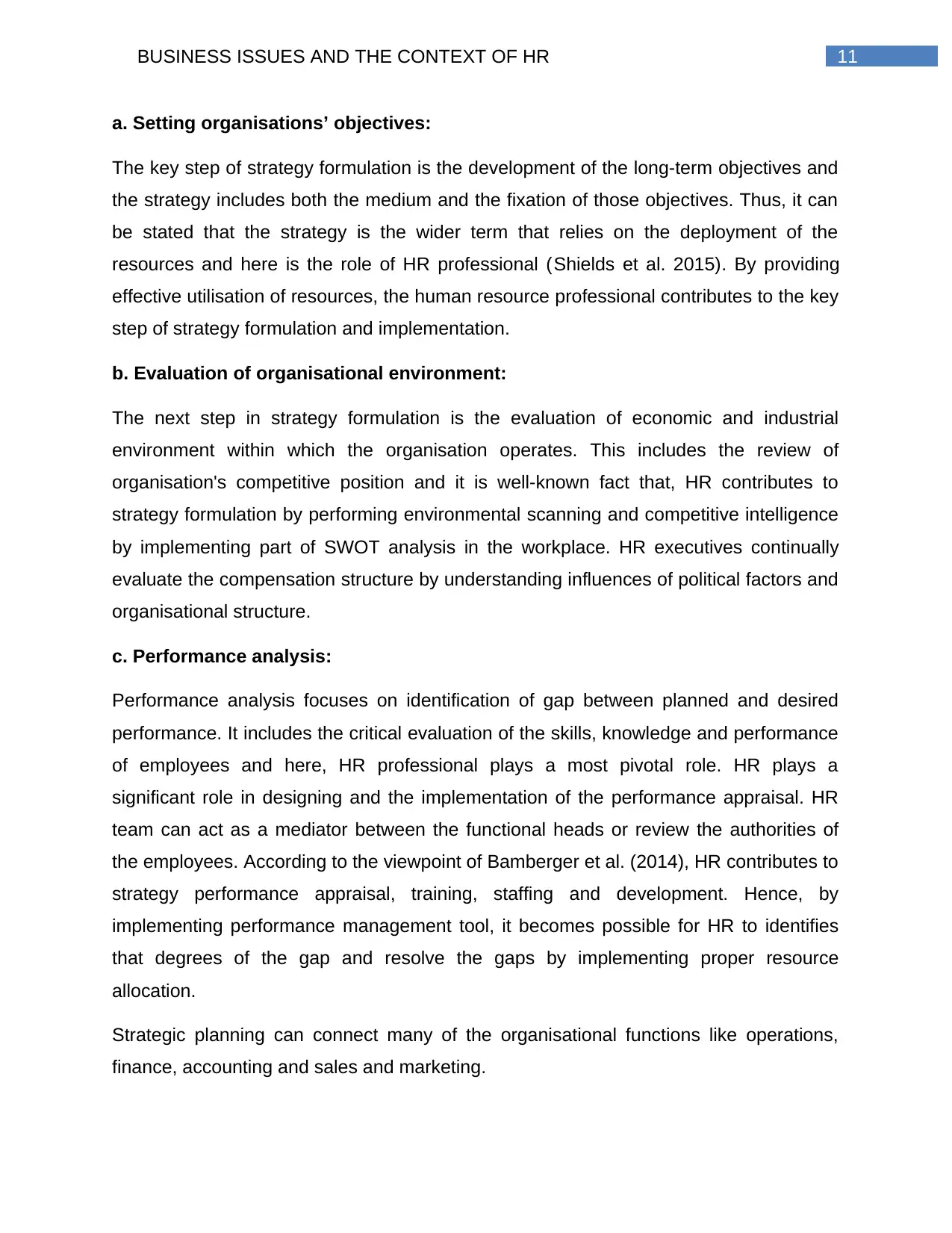
11BUSINESS ISSUES AND THE CONTEXT OF HR
a. Setting organisations’ objectives:
The key step of strategy formulation is the development of the long-term objectives and
the strategy includes both the medium and the fixation of those objectives. Thus, it can
be stated that the strategy is the wider term that relies on the deployment of the
resources and here is the role of HR professional (Shields et al. 2015). By providing
effective utilisation of resources, the human resource professional contributes to the key
step of strategy formulation and implementation.
b. Evaluation of organisational environment:
The next step in strategy formulation is the evaluation of economic and industrial
environment within which the organisation operates. This includes the review of
organisation's competitive position and it is well-known fact that, HR contributes to
strategy formulation by performing environmental scanning and competitive intelligence
by implementing part of SWOT analysis in the workplace. HR executives continually
evaluate the compensation structure by understanding influences of political factors and
organisational structure.
c. Performance analysis:
Performance analysis focuses on identification of gap between planned and desired
performance. It includes the critical evaluation of the skills, knowledge and performance
of employees and here, HR professional plays a most pivotal role. HR plays a
significant role in designing and the implementation of the performance appraisal. HR
team can act as a mediator between the functional heads or review the authorities of
the employees. According to the viewpoint of Bamberger et al. (2014), HR contributes to
strategy performance appraisal, training, staffing and development. Hence, by
implementing performance management tool, it becomes possible for HR to identifies
that degrees of the gap and resolve the gaps by implementing proper resource
allocation.
Strategic planning can connect many of the organisational functions like operations,
finance, accounting and sales and marketing.
a. Setting organisations’ objectives:
The key step of strategy formulation is the development of the long-term objectives and
the strategy includes both the medium and the fixation of those objectives. Thus, it can
be stated that the strategy is the wider term that relies on the deployment of the
resources and here is the role of HR professional (Shields et al. 2015). By providing
effective utilisation of resources, the human resource professional contributes to the key
step of strategy formulation and implementation.
b. Evaluation of organisational environment:
The next step in strategy formulation is the evaluation of economic and industrial
environment within which the organisation operates. This includes the review of
organisation's competitive position and it is well-known fact that, HR contributes to
strategy formulation by performing environmental scanning and competitive intelligence
by implementing part of SWOT analysis in the workplace. HR executives continually
evaluate the compensation structure by understanding influences of political factors and
organisational structure.
c. Performance analysis:
Performance analysis focuses on identification of gap between planned and desired
performance. It includes the critical evaluation of the skills, knowledge and performance
of employees and here, HR professional plays a most pivotal role. HR plays a
significant role in designing and the implementation of the performance appraisal. HR
team can act as a mediator between the functional heads or review the authorities of
the employees. According to the viewpoint of Bamberger et al. (2014), HR contributes to
strategy performance appraisal, training, staffing and development. Hence, by
implementing performance management tool, it becomes possible for HR to identifies
that degrees of the gap and resolve the gaps by implementing proper resource
allocation.
Strategic planning can connect many of the organisational functions like operations,
finance, accounting and sales and marketing.
⊘ This is a preview!⊘
Do you want full access?
Subscribe today to unlock all pages.

Trusted by 1+ million students worldwide
1 out of 23
Related Documents
Your All-in-One AI-Powered Toolkit for Academic Success.
+13062052269
info@desklib.com
Available 24*7 on WhatsApp / Email
![[object Object]](/_next/static/media/star-bottom.7253800d.svg)
Unlock your academic potential
Copyright © 2020–2025 A2Z Services. All Rights Reserved. Developed and managed by ZUCOL.





